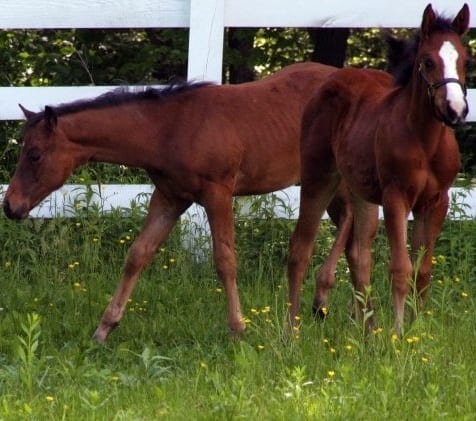As more and more individuals in the industry are performing multiple embryo transfers the same year with the same mare, there are some questions surfacing regarding the moral ramifications of allowing this practice to be unregulated. Many horse lovers are not sure that “horses should have litters.” There is conflict between the advancement of science and the belief that horses typically only have one foal a year. It appears to be more of a gray area of scientific advancement and is more readily accepted in the horse industry–unlike cloning which tends to create an automatic negative reaction from most individuals in equine related fields.
Dr. Nathaniel Wright, DVM of Equine Medical Associates located in Thompson Station, Tennessee performs embryo transfers and says that he currently doesn’t have any problem with implanting multiple embryos in recipient mares as long as it doesn’t lead to a huge overpopulation of unwanted horses. “Most mares that are used for this purpose are high quality mares; the number of eggs that the mare can produce is also a limiting factor, and it is quite expensive, so, the individuals that are paying for these procedures usually have the money to pay for the horses that result from implanting multiple embryos. As long as this practice doesn’t result in a huge overpopulation of offspring like it has in the thoroughbred industry due to over breeding in that industry, then, I think it is fine and does not present a huge moral dilemma.”
 One top AQHA breeder who asked to remain anonymous explained that she thought that the ability for breeders to implant multiple embryos without any limits caters to the wealthy few in the industry. “AQHA is trying to even the playing field, but the fact the top mares, top breeders, and top exhibitors can produce multiple foals a year doesn’t help outsiders trying to get into the industry, and it doesn’t send the right message or help create a positive feeling that they can compete in the industry,” she said. “I think it makes people too greedy and the welfare of the animal is being compromised. I think flushing so many embryos a year messes up their reproductive system and damages the uterus in the long run. I believe their body needs to have the opportunity to carry a foal so their body can hit the reset button. I have a mare that has been unable to get in foal because we flushed too many embryos, and it has been very hard on her reproductive system.”
One top AQHA breeder who asked to remain anonymous explained that she thought that the ability for breeders to implant multiple embryos without any limits caters to the wealthy few in the industry. “AQHA is trying to even the playing field, but the fact the top mares, top breeders, and top exhibitors can produce multiple foals a year doesn’t help outsiders trying to get into the industry, and it doesn’t send the right message or help create a positive feeling that they can compete in the industry,” she said. “I think it makes people too greedy and the welfare of the animal is being compromised. I think flushing so many embryos a year messes up their reproductive system and damages the uterus in the long run. I believe their body needs to have the opportunity to carry a foal so their body can hit the reset button. I have a mare that has been unable to get in foal because we flushed too many embryos, and it has been very hard on her reproductive system.”
According to Trent Taylor, who is the AQHA Treasurer and Executive Director of Operations, the first embryo transfer rule was in 1985 and was changed several times through the years. Prior to 2002, only one foal could be registered, but there were no restrictions on the number of embryos. There were restrictions on Parentage Verification, Location and notification to AQHA.
“Specifically, registration eligibility of embryo transfer foals was the subject of litigation in 2002 in the case styled Kay Floyd; Dan Churchill; Paula and Kobie Wood; and Lannie Mecom Individually and dba Wichita Ranch, General Partner of Wichita Partnership, Ltd. V. AQHA;251stDistrict Court of Potter County, Texas. The rule exists in its current form as a result of a Court approved settlement of that litigation effective August 2002,” Taylor said in an email to GoHorseShow.com. “AQHA does not presently anticipate any changes to the rule being placed on the Stud Book and Registration Committee’s agenda. However, as with any registration rule, it is possible that circumstances in the future might change such that a review of the rule may be warranted although trying to predict what those circumstances may be is obviously difficult.”
 Horse trainer Gail Emmons Mitchell, who worked for Gumz Farms during last year’s breeding season, says that multiple embryo transfers is a benefit to the industry. “The industry is in a crisis right now in that there is a limited amount of truly great horses available for breeding. There are next to no new investors and people have dramatically cut back on breeding. This all means there will be an even greater paucity of great horses being produced. A mare worthy of going to the expense of recovering multiple embryos is good for the breeding industry the industry ought to encourage someone whom thinks so much of to invest in the industry with multiple embryos.”
Horse trainer Gail Emmons Mitchell, who worked for Gumz Farms during last year’s breeding season, says that multiple embryo transfers is a benefit to the industry. “The industry is in a crisis right now in that there is a limited amount of truly great horses available for breeding. There are next to no new investors and people have dramatically cut back on breeding. This all means there will be an even greater paucity of great horses being produced. A mare worthy of going to the expense of recovering multiple embryos is good for the breeding industry the industry ought to encourage someone whom thinks so much of to invest in the industry with multiple embryos.”
Top breeder, Amy Gumz of Gumz Farms also adds, “I don’t know that ethics play into this decision but more like supply and demand. Stallions can sire hundreds of foals through artificial means so why should mares be limited to one? The great mares will have embryos in demand and therefore will create a need for multiple embryos. I think the decision to flush multiple embryos need to be made carefully.”
However, Katie Mitchell of Mitchell Show Horses who specializes in halter horses has a different take on the embryo transfer issue.
“We have seen a slow down in sales of horses. No one wants to breed more if they cannot sell what they already have. It is a shame really, as we have created this ourselves with the implementing of Embryo Transfer. Now we can flush as many times as we have the will to do, then get the offspring the following year, and maybe only promote one or two,” Mitchell said. “What happens to the others? You can’t sell them. You feed, care, and train on them for another year, or 2 or 3. Then your expenses rise because you have too many horses because you know you have flushed the same number the following year, and the following…then, you are overrun with stock, you can’t afford to care for them anymore, you are then convinced to no longer breed anything, until you get rid of what you have.”
 Debbi Trubee, who is the breeding manager along with Roger Landis at Pine View Farms, does multiple embryos on their farm on several mares every year, and she says it is amazing to her the difference in the foals. “Even though they are full siblings, they really can differ in all aspects… on several occasions we have flushed twin embryos out of mares, transferred them, both were carried to term, and the babies are tee totalin’ different individuals. It still boils down to having to have a great individual to bring good money. Just because they look good on paper doesn’t mean they are a great prospect so the fear of having too many out of mare X and causing mare X’s babies to have less value doesn’t apply in my eyes. That was the initial fear that getting multiple embryos out of great mares would devalue those babies…They wouldn’t be one of a kind anymore. And since studs can sire 100’s a year, who’s to say you should only get one per mare a year?”
Debbi Trubee, who is the breeding manager along with Roger Landis at Pine View Farms, does multiple embryos on their farm on several mares every year, and she says it is amazing to her the difference in the foals. “Even though they are full siblings, they really can differ in all aspects… on several occasions we have flushed twin embryos out of mares, transferred them, both were carried to term, and the babies are tee totalin’ different individuals. It still boils down to having to have a great individual to bring good money. Just because they look good on paper doesn’t mean they are a great prospect so the fear of having too many out of mare X and causing mare X’s babies to have less value doesn’t apply in my eyes. That was the initial fear that getting multiple embryos out of great mares would devalue those babies…They wouldn’t be one of a kind anymore. And since studs can sire 100’s a year, who’s to say you should only get one per mare a year?”
Stephanie Griffin who did multiple embryo transfers on her World and Congress Champion mare Scotch Margarita has these thoughts on the issue. “I understand people’s concern about it, but really I’d rather see a few embryos a year out of famous mares than everyone breeding backyard mares to backyard stallions resulting in a surplus of below average horses that flood the market, lower prices and sometimes lead to them being kept in unfavorable conditions with owners that can’t afford to properly care for them.”
As the procedures of embryo transfer advance, more moral issues will arise. Inherently, a mare produces one foal per year, yet this technology significantly increases that figure. Unfortunately, the consequences are still unknown. Without regulation, ET could create a large impact on the gene pool and horse population. In certain cases, ET is used to produce foals from reproductively unsound mares. That scenario potentially harms the next generation by passing on the genes for the unsoundness.
Additionally, the surgical method is a highly invasive procedure. However, Dr. Ryan Ferris, DVM of Colorado State University says that there is no evidence that flushing multiple embryos hurts the mare. “The mares may exhibit some inflammatory changes in the uterus, but they are not abnormal and are even comparable to mares that are bred in the wild. Also, we have done studies comparing the birth rates of naturally covered mares versus ones that have been done through embryo transfers and the foals appear to be just as healthy.”
So, what does the GoHorseShow.com readers think about this issue? Let us know in the comment section of this article.








